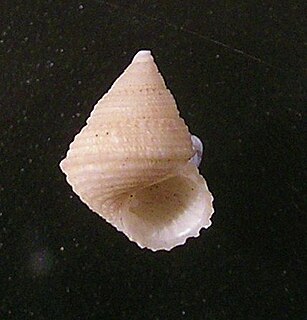
Coscinasterias is a genus of sea stars of the family Asteriidae.
The World Register of Marine Species (WoRMS) is a taxonomic database that aims to provide an authoritative and comprehensive list of names of marine organisms.

Seguenzioidea is a superfamily of minute to medium-sized sea snails, marine gastropod mollusks in the clade Vetigastropoda.

The Echinacea are a superorder of sea urchins. They are distinguished by the presence of a rigid test, with ten buccal plates around the mouth, and solid spines. Unlike some other sea urchins, they also possess gills. The group is a large one, with species found worldwide.

Pleurotomella is a genus of sea snails, marine gastropod mollusks in the family Raphitomidae.

Gymnobela is a genus of sea snails, marine gastropod mollusks in the family Raphitomidae.

Bela is a genus of sea snails; marine gastropod mollusks in the family Mangeliidae.

Skenea is a genus of small to minute sea snails, marine gastropod mollusks in the family Skeneidae.

Synaptidae is a family of sea cucumbers that have no tube feet, tentacle ampullae, retractor muscles, respiratory trees, or cuvierian tubules. They also lack radial canals of the water-vascular system, with only the circumoral ring present.

Cucumariidae is a family of sea cucumbers, marine animals with elongated bodies, leathery skins and tentacles that are found on the sea bed.

The Camarodonta are an order of globular sea urchins in the class Echinoidea. The fossil record shows that camarodonts have been in existence since the Lower Cretaceous.

Raphitomidae is a family of small to medium-sized sea snails, marine gastropod mollusks in the superfamily Conoidea.

Abatus cordatus is a species of sea urchin in the family Schizasteridae. It is native to shallow seas surrounding certain island groups in the southern Indian Ocean. The body is protected by a hard test or shell which is covered with spines. The female broods its young in deep pockets on the upper surface, retaining the young in place with specialised spines. American zoologist Addison Emery Verrill first scientifically described A. cordatus in 1876.

Brissus obesus is a species of sea urchins of the Family Brissidae. Their armour is covered with spines. Brissus obesus was first scientifically described in 1867 by Verrill.

Ocnus is a genus of sea cucumbers in the family Cucumariidae.

Tetrapygus is a genus of sea urchins in the family Arbaciidae. It is a monotypic genus and the only species is Tetrapygus niger which was first described by the Chilean naturalist Juan Ignacio Molina in 1782. It is found in the southeastern Pacific Ocean on the coasts of South America.

Lytechinus pictus, commonly known as the painted urchin, is a sea urchin in the family Toxopneustidae. It occurs on shallow reefs in the tropical and subtropical eastern Pacific Ocean, off the coasts of California, Central America and South America as far south as Ecuador.
Astriclypeidae is a family of echinoderms belonging to the order Clypeasteroida.

Pourtalesia miranda, commonly known as the wonderful sea urchin, is a species of sea urchin in the family Pourtalesiidae. It is found at abyssal depths in the Atlantic Ocean.
Astriclypeus is a genus of echinoderms belonging to the family Astriclypeidae.


















